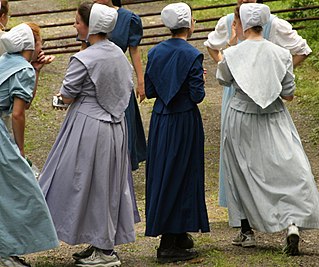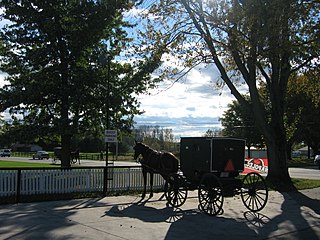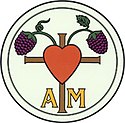
The Church of the Brethren is an Anabaptist Christian denomination with origins in the Schwarzenau Brethren that was organized in 1708 by Alexander Mack in Schwarzenau, Germany. The denomination holds the New Testament as its only creed. Historically, the church has taken a strong stance for nonresistance or pacifism—it is one of the three historic peace churches, alongside the Mennonites and Quakers. Distinctive practices include believer's baptism by forward trine immersion; a threefold love feast consisting of feet washing, a fellowship meal, and communion; anointing for healing; and the holy kiss. Its headquarters are in Elgin, Illinois, United States.

Plain people are Christian groups characterized by separation from the world and by simple living, including plain dressing in modest clothing. Many Plain people have an Anabaptist background. These denominations are largely of German, Swiss German and Dutch ancestry, though people of diverse backgrounds have been incorporated into them. Conservative Friends are traditional Quakers who are also considered plain people; they come from a variety of different ethnic backgrounds.

The Old German Baptist Brethren (OGBB) is a conservative Plain church which emerged from a division among the German Baptist Brethren in 1881 being part of the Old Order Movement. Like the church it emerged from, it has roots both in Anabaptism and in Radical Pietism. It practices adult believers baptism as the biblically valid form of baptism. It is also characterized by strict religious adherence with rejection of modern culture and modern assimilation. It is one of several Schwarzenau Brethren groups that trace their roots to 1708, when eight believers founded a new church in Schwarzenau, Germany. The Old German Baptist Brethren church has about 4,000 baptized members.

The Schwarzenau Brethren, the German Baptist Brethren, Dunkers, Dunkards, Tunkers, or sometimes simply called the German Baptists, are an Anabaptist group that dissented from Roman Catholic, Lutheran and Reformed European state churches during the 17th and 18th century. German Baptist Brethren emerged in some German-speaking states in western and southwestern parts of the Holy Roman Empire as a result of the Radical Pietist revival movement of the late 17th and early 18th centuries.

The Old Order River Brethren are a small Old Order River Brethren denomination of Anabaptist Christianity with roots in the Mennonite Church and the Radical Pietist movement of the Schwarzenau Brethren.

A horse and buggy or horse and carriage refers to a light, simple, two-person carriage of the late 18th, 19th and early 20th centuries, drawn usually by one or sometimes by two horses. Also called a roadster or a trap, it was made with two wheels in England and the United States. It had a folding or falling top.

Old Order Mennonites form a branch of the Mennonite tradition. Old Order are those Mennonite groups of Swiss German and south German heritage who practice a lifestyle without some elements of modern technology, who still drive a horse and buggy rather than cars, wear very conservative and modest dress plainly and who have retained the old forms of worship, baptism and communion.
Weavertown Amish Mennonite Church is a Beachy Amish Mennonite congregation located in the village of Weavertown, between the somewhat larger villages of Bird-in-Hand and Intercourse in Lancaster County, Pennsylvania, United States.
The Stauffer Mennonites, or "Pikers", are a group of Old Order Mennonites. They are also called "Team Mennonites", because they use horse drawn transportation. In 2015 the Stauffer Mennonites had 2,010 adult members.

The Beachy Amish Mennonites, also known as the Beachy Mennonites, are an Anabaptist group of churches in the Conservative Mennonite tradition that have Amish roots. Although they have retained the name "Amish" they are quite different from the Old Order Amish: they do not use horse and buggy for transportation, with a few exceptions they do not speak Pennsylvania German anymore, nor do they have restrictions on technology except for radio and television. In the years 1946 to 1977 a majority was transformed into an evangelical revivalist denomination. The traditionalists who wanted to preserve the old Beachy Amish ways then withdrew and formed their own congregations. Today they are known as Midwest Beachy Amish Mennonites or Old Beachy Amish.

Plain dress is a practice among some religious groups, primarily some Christian churches in which people dress in clothes of traditional modest design, sturdy fabric, and conservative cut. It is intended to show acceptance of traditional gender roles, modesty, and readiness to work and serve, and to preserve communal identity and separation from the immodest, ever-changing fashions of the world. For men, this often takes the form of trousers secured by suspenders, while for women, plain dress usually takes the form of a cape dress along with a headcovering.

The Groffdale Conference Mennonite Church, also called Wenger Mennonites, is the largest Old Order Mennonite group to use horse-drawn carriages for transportation. Along with the automobile, they reject many modern conveniences, while allowing electricity in their homes and steel-wheeled tractors to till the fields. Initially concentrated in eastern Lancaster County, Pennsylvania, their numbers had grown to 22,305 people resided in eight other states as of 2015. They share the pulpit with the Ontario Mennonite Conference but have some differences in Ordnung.

The Old Brethren German Baptists, also called Leedyites, are the most conservative group of Schwarzenau Brethren. They live in Indiana and Missouri.
Subgroups of Amish developed over the years, as Amish churches have divided many times over doctrinal disputes. The 'Old Order' Amish, a conservative faction that withdrew from fellowship with the wider body of Amish in the 1860s, are those that have most emphasized traditional practices and beliefs. There are many different subgroups of Amish with most belonging, in ascending order of conservatism, to the Beachy Amish, New Order, Old Order, or Swartzentruber Amish groups.

The Old Brethren are a group of Schwarzenau Brethren who split from the Old German Baptist Brethren in Carroll County, Indiana, in 1913, and in Stanislaus County, California, in 1915. They are a believer's church made up of those who voluntarily choose to follow Jesus as His disciples, and are baptized at this time, during their teen or adult years.
Brethren is a name adopted by a wide range of mainly Christian religious groups throughout history. The largest movement is Anabaptist.

The Byler Amish, also called Alt Gemee, are a small conservative subgroup of the Amish. They are known for the yellow color of their buggies, which earned them the nickname "yellow-toppers" and for wearing only one suspender. They are the oldest Old Order Amish affiliation that separated for doctrinal and not for geographical reasons.
Old Order Brethren are Old Order plain groups of the Schwarzenau Brethren, as well as the River Brethren—both Anabaptist Christian traditions. There are five of these “Old Order” groups of the Schwarzenau Brethren:
The Old Order Movement is a religious movement to preserve the old ways of Anabaptist religion and lifestyle. Historically, it emerged in the second half of the 19th century among the Amish, Mennonites of South German and Swiss ancestry as well as the Schwarzenau Brethren and River Brethren in the United States and Canada. The movement led to several Old Order divisions from mainstream Anabaptist groups between 1845 and 1901. All Old Order groups that emerged after 1901 divided from established Old Order groups or were formed by people coming from different Old Order groups. The highly conservative Old Colony Mennonites and the Hutterites were not directly connected to this movement.
The New Order Amish Fellowship or New New Order Amish, most commonly called New Order Christian Fellowship, is the most progressive affiliation among the New Order Amish. Because some scholars see the New Order Amish just as a subgroup of the Old Order Amish, the New Order Christian Fellowship is thus the most progressive affiliation among the Old Order Amish. In spirituality, they are close to Beachy Amish. Their use of horse and buggy transportation and their preservation of the German language distinguishes them from the Beachys, except for the Old Beachy Amish who have also retained the German language but drive cars.








